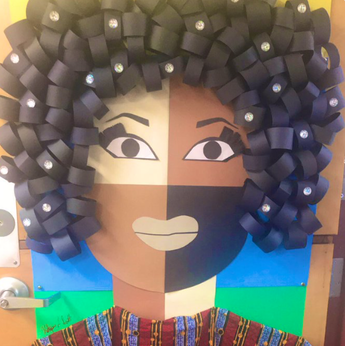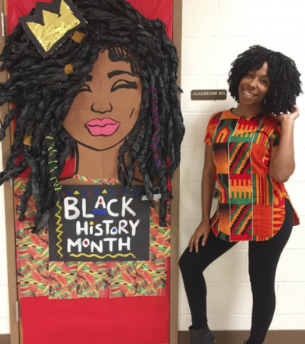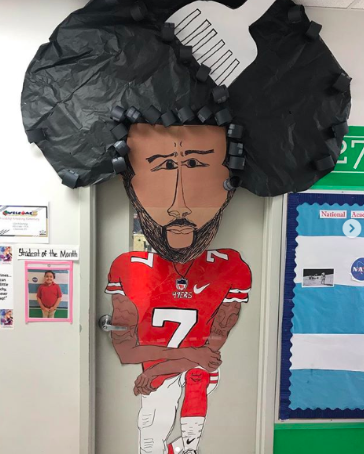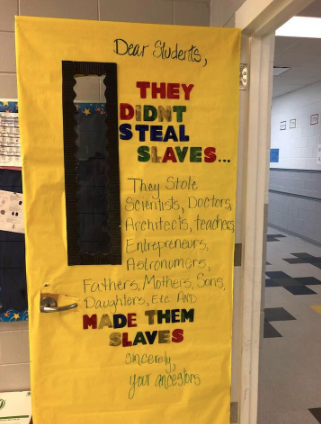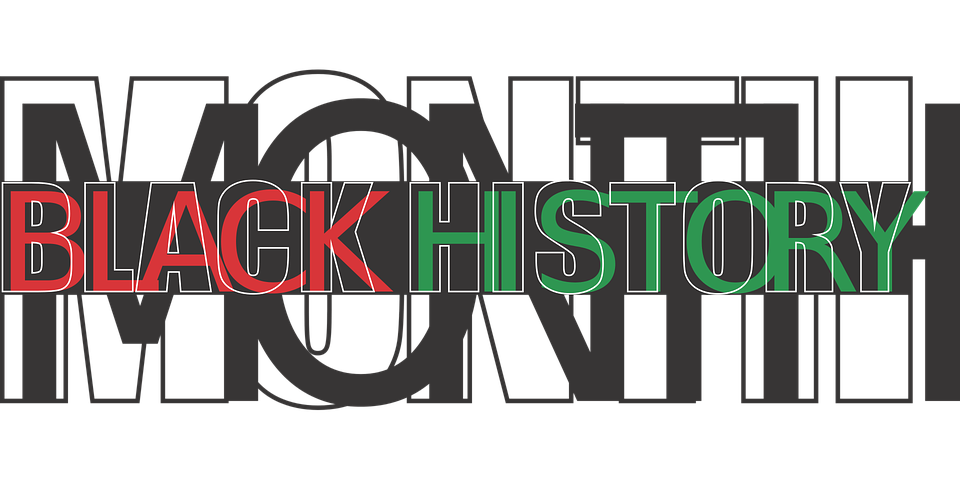|
Black History Month is a month-long celebration that recognizes the accomplishments and impacts of African Americans throughout history. It also highlights the work of African American leaders today. Since 1926, Black History Month has reigned victoriously throughout the month of February in the United States and each year, there are newcomers making their mark and doing it ‘For the Culture’. Black History Month 2019 is well under way and teachers across the country have taken note. They are paying homage to African American culture and heritage with decorative doors showcasing powerful images and messages. Below are several of the creative pieces: The first image is simple yet striking because it touches upon the issue of colorism. It depicts a black woman with diamonds attached to her large curls while wearing a dashiki. The face of the woman is sectioned off into four quadrants that illustrate the different shades of the black race. The creator, Twitter user @killahkat, shared her creation on the site accompanied by the statement, “Any shade of black is beautiful!” The next piece by elementary art teacher, Chanique Davis, present trademarks of black culture. It displays, again, a black woman but with 3-dimensional dreads, gelled down ‘baby’ hairs and beads, all while wearing a crown. In addition, her facial features are accentuated with plump, full lips, a broad nose and bushy but tamed brows. Davis posted her highly detailed work on Instagram with captions “Tis the season! It’s Black History Month and it’s like a holiday over here at Lake Alfred.” Similarly, modern-day leaders and activists, like Lady O (Oprah) and Colin Kaepernick, were honored on a door. Glen Mourning at Friendship Public Charter School in Washington DC wanted to remind others that the fight for equality and justice in America is not over, so he used Colin Kaepernick. He portrays Kaepernick famously kneeling with arms crossed in the San Francisco 49ers uniform alongside a full afro and hair-pick comb. In a statement he gave to People Magazine, he said, “The fact is, kneeling done by Kaepernick and others was viewed by many as showing love and positivity in the form of peaceful protesting and exercising our rights… We need to keep the dialogue going!” Last but not least, charter school teacher, Jovan Bradshaw decided to take the literary route with her BHM appreciation. She found inspiration from another appreciator, Nadine Keen, but manifested her presentation with personal flare. She wrote the following quote, “Dear Students, THEY DIDN’T STEAL SLAVES … They stole scientists, doctors, architects, teachers, entrepreneurs, astronomers, fathers, mothers, sons, daughters, etc. and MADE THEM SLAVES. Sincerely, your ancestors.” These teachers put in the extra effort to not only capture the attention of their students but also have them realize the importance of this holiday season as they live through it. All of their efforts were not in vain, the doors have both gained national attention and inspired a BHM door competition through media giant Pinterest.
1 Comment
Although the name Elijah McCoy may be unknown to most people, the enormity of his ingenuity and the quality of his inventions have created a level of distinction which bears his name. Elijah McCoy was born in Colchester, Ontario, Canada on May 2, 1844. His parents were George and Emillia McCoy, former slaves from Kentucky who escaped through the Underground Railroad. George joined the Canadian Army, fighting in the Rebel War and then raised his family as free Canadian citizens on a 160 acre homestead. At an early age, Elijah showed a mechanical interest, often taking items apart and putting them back together again. Recognizing his keen abilities, George and Emillia saved enough money to send Elijah to Edinburgh, Scotland, where he could study mechanical engineering. After finishing his studies as a “master mechanic and engineer” he returned to the United States which had just seen the end of the Civil War – and the emergence of the “Emancipation Proclamation.” There are 1 billion search results for the phrase, "How to be positive" on Google. It makes me wonder: Does it help to be optimistic in times of change and uncertainty? And if so, how do we stay optimistic during tough turbulent times? Does it help to be optimistic? I believe the answer is YES. Here's why: Being optimistic allows us to get up and try again. Like most of us, I've been on both sides of the fence. Sometimes pessimistic, other times optimistic. And even the middle path of a realist who often struggles with trying to be hopeful in the face of brutal facts. Frederick Douglass, who has been called the greatest American of the nineteenth century, grew up as a slave named Frederick Bailey, and the story of how he named himself in freedom shows how complicated his life, and his world, always was. Frederick’s father, as David W. Blight shows in his extraordinary new biography, “Frederick Douglass: Prophet of Freedom” (Simon & Schuster), was almost certainly white, as Douglass knew early on, and there is something almost cruelly parodic in the grand name the child slave was given: Frederick Augustus Washington Bailey. Escaping to freedom in 1838, at the age of twenty, and needing a new name—in part as a declaration of a reinvented self, in part for the practical necessity of eluding the slave-catchers—he chose to become Frederick Douglass, in honor of a character in a Walter Scott poem. (He added an extra “s” for distinction.) |
The FDF LifestyleThis page includes blogs, healthy articles, inspiring pictures, exercise tutorials, music, etc. No content on this site, regardless of date, should ever be used as a substitute for direct medical advice from your doctor or other qualified clinician. Archives
April 2024
Visit this section daily to become more healthy and positive.Strengthen your mind by consistently learning new information.
New articles are uploaded throughout the week. |
Live |
Life |
To |
The |
Fullest |
Family Dreams Fitness LLC (www.familydreamsfitness.com) is not responsible or liable for any advice, course of treatment, diagnosis or any other information, services or products that you obtain through this site. You are encouraged to consult with your doctor with regard to this information contained on or through this website. After reading articles, watching videos or reading other content from this website, you are encouraged to review the information carefully with your professional healthcare provider.
You should understand that when participating in any exercise or exercise program, there is the possibility of physical injury. If you engage in any exercise or exercise program on this website, you agree that you do so at your own risk, are voluntarily participating in these activities, assume all risk of injury to yourself, and agree to release and discharge Family Dreams Fitness LLC from any and all claims or causes of action, known or unknown, arising out of Family Dreams Fitness LLC.

